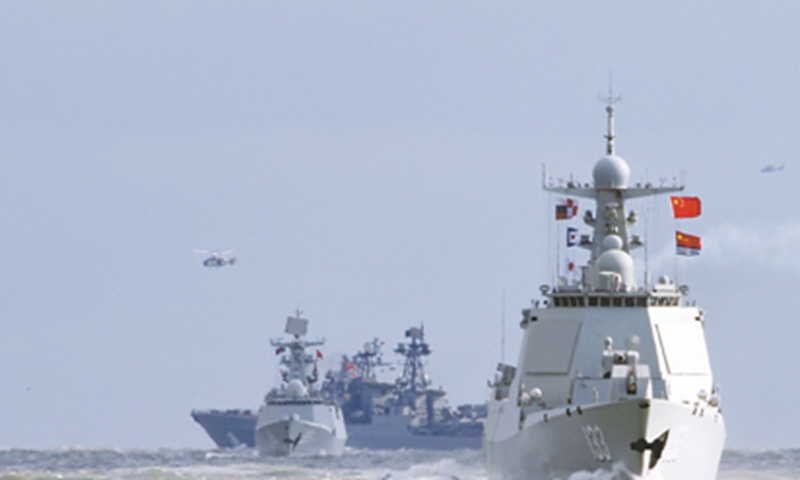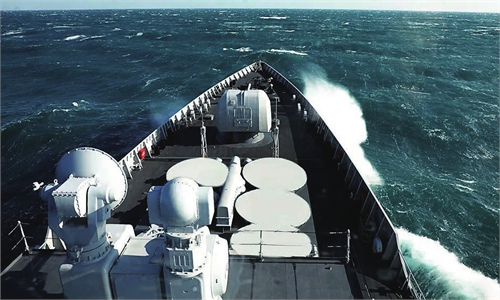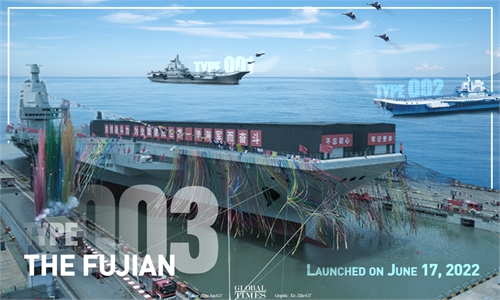
Chinese and Russian naval forces successfully concluded their weeklong routine joint drills in the East China Sea on December 27, 2022. Photo: Courtesy of Li Yun
Chinese and Russian naval forces successfully concluded their week-long routine joint drills in the East China Sea on Tuesday, with Chinese navy commanders revealing to the Global Times that actual combat performances and innovation were highlights during the exercise, which focused on joint maintenance of maritime security.Chinese naval forces from the People's Liberation Army (PLA) Eastern and Northern theater commands, including the Type 052D destroyer Baotou, the Type 052C destroyer Jinan, the Type 054A frigates Binzhou and Yancheng, the Type 903A comprehensive supply ship Gaoyouhu, as well as a submarine, fixed wing early warning aircraft, anti-submarine patrol aircraft and vessel-borne helicopters, participated in the Joint Sea 2022 from December 21 to 27, the Global Times has learned.
According to the Russian press release, the Russian Navy sent the guided missile cruiser Varyag, the frigate Marshal Shaposhnikov and the Project 20380 corvettes Hero of the Russian Federation Aldar Tsydenzhapov and Sovershennyy, as well as aircraft and helicopters belonging to the naval aviation forces under the Russian Pacific Fleet.
Joint Sea 2022 marks the 10th anniversary since the first drills in this series took place in 2012, and the latest naval drill consolidated experience and partnership between the two militaries over the past decade, the Global Times learned from Chinese officials.
Focusing on joint maintenance of maritime security, the two naval forces worked and coordinated with each other with solidarity, overcoming adversity created by bad weather. The exercise involved joint operations on blockade and control, visits, boarding, search and seizure (VBSS), air defense, rescue, anti-submarine and other mock situations. Life-fire shooting of main battle weapons including air defense missiles and rocket depth charge were also rehearsed.
The joint operations were conducted under rotational guidance or joint direction from two sides.
Shao Jianpeng, captain of the Type 054A frigate Binzhou which participated in the joint drills, revealed that during the air defense practice, China and Russia both sent out their elite warships, forming an air defense formation and working closely under seamless command to effectively cope with a variety of threats.
Shao said that it is safe to say that the drills showcased the most advanced air defense capability to date belonging to the two sides, as well as the great combat abilities and military skills of the two naval forces.
The steering rooms of Chinese destroyer Jinan and Russian guided missile cruiser Varyag were set as the main venues for the closing ceremony of Joint Sea 2022 on Tuesday morning. Other ships and crews participated in the event via audio link.
Rear Admiral Wang Yu, the executive director of Joint Sea 2022 from the Chinese side, announced the start of the closing event at around 9:30 am.
In the past seven days, military officers from both sides smoothly completed all the set practice goals, and the joint drill has deepened cooperation and friendship between the two sides and boosted overall capabilities.
Wang stressed that "as the relations between the two countries and militaries grow deeper and deeper, the prospect of pragmatic cooperation between the two naval forces will become broader. And we shall certainly be more capable of making new and greater contributions to the cause of safeguarding world and regional peace."
The joint drills showcase the two countries' strength and resolve to safeguard peace and stability in the region, especially at a time when the US keeps promoting its "Indo-Pacific Strategy" and constantly increasing military deployment in the Western Pacific ocean, while Japan has broken away from its defense-only principle, provocatively instigating tensions over hotspot issues involving the Taiwan Straits, Korean Peninsula and the South China Sea, military expert Wei Dongxu told the Global Times on Tuesday.
Wei noted that the anti-submarine practice was one of the highlights during the Joint 2022, where the two sides could invest top-notch forces and their best weapons to carry out real combat-like adversarial practice, from which both sides could learn a lot.




